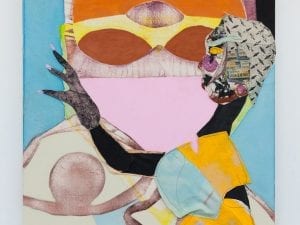British painter and professor Laurence Wood is currently living and working in Hong Kong. A finalist in the 2014 Arte Laguna Prize, his recent exhibitions include Choice Emblems, a solo show at Lacey Contemporary Gallery in London, and Mysticism in Landscape at Nadine Fine Art SE Asia in Kuala Lumpur. Aesthetica discuss with him the notion of influence and cultural awareness.
A: Your paintings are often inspired by travelling to South East Asia. Do you think that artists are inherently influenced by what they see on a day-to-day basis, and in that case become culturally confined by what they know?
LW: I think a visual artist is influenced by what is around them and what is within them. Interpreting or translating our day-to-day environment is about much more than what simply meets the eye. I suspect we are all culturally confined in one way or another, and to different degrees but I think that the opportunity for us all to be more open to influences from the world’s cultures and sub-cultures has never been greater due to the internet, TV, movies, travel and migration. Cultural confinement for a contemporary artist or art student would be a life choice!
A: How do you think that you have reflected certain aspects of the culture through the expressive potential of colour?
LW: My work has become less naturalistic and more symbolic since living and working in Hong Kong. The culture of “Eastern” symbolic paintings and prints has influenced me, allowing colour to have a more independent expressive function, less tied-up with a purely descriptive role. For sure the rush of vibrant sub-tropical and tropical colours kick-started major changes in my work.
A: In such bright paintings, is colour theory important to you and why?
LW: Colour theory is important in gaining an understanding of the key characteristics of colours such as hue, chroma and tone, and how colours behave solo or in unison, especially in terms of how one can create a sense of space behind or in front of the picture plane. This applies whether I am using a bright or a subdued palette.
A: How do you think painting in particular creates a kind of visual poetry, through shape, colour, structure and imagery on a canvas?
LW: Those elements, along with pattern, rhythm, metaphor, symbolism, emotion, ideas, meaning, illusion, gesture, and others too, are there in full view, presented at the same time in the same place. The viewer looks at the whole whilst simultaneously noticing or seeing the parts. The artist has assembled everything, connected the parts and condensed it into a final concentrated form but the viewer can still start anywhere, make their own connections, use their own imagination, follow their own interpretations. The experience of painting is essentially transcendental.
A: If this is the case, is there a kind of narrative that you adhere to?
LW: No, I don’t consciously adhere to a narrative. Some paintings have one imposed on them, some don’t. Sometimes one develops as the painting develops. The same applies to the titles of my work. Sometimes they guide the work, other times they follow it. I love it when a painting gets where I want it to be and also somehow manages to tell the story of its own making through the pentimenti.
A: Why did you begin to paint?
LW: Making paintings at school and looking at paintings in books always captivated me as a child, though I was seventeen before I saw a real painting in a gallery. It was a large abstract work Juggernaut with Plume by John Walker and I thought it was really powerful and I wanted to find out more, which led me to art school and when I got there it fitted like a glove.
A: Do you think that the process is multi-layered, both within the processes it takes to complete a piece and in the meditations that exist between artwork and artist as it comes into being?
LW: Yes, sometimes I can’t believe what a multi-layered experience painting is! For me painting is usually a building up of physical layers of paint whilst simultaneously layering, up or down, the ideas. This can sometimes be a smooth simple fusion of both or the most complex and frustrating battle.
Find out more: www.laurencewood.co.uk
Credits:
1. Laurence Wood, Peacock Happy Hour Painting (Catallus). Courtesy of the artist.





